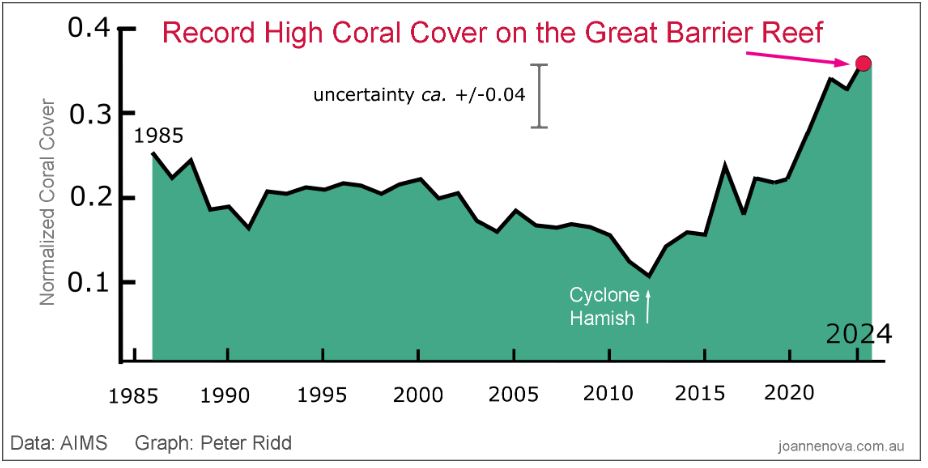
After a trillion tons of CO2, the Great Barrier Reef hits record coral cover third year in a row
By Joanne Nova
Sixty percent of all human CO2 emissions have been emitted since 1985, but today, the corals are healthier than ever
In 1985 humans were emitting only 19.6 billion tons of CO2 each year, and now we emit 37 billion tons. In the meantime, AIMS have been dragging divers thousands of kilometers over the reefs to inspect the coral cover. These are the most detailed underwater surveys on the largest reef system in the world, and they show that far from being bleached to hell, the corals are more abundant than we have ever seen them.
As Peter Ridd points out, when the reef was doing badly, AIMS was happy to combine the data on the whole reef so we could lament its demise. But lately, AIMS splits it into separate sections, and if Peter Ridd didn’t check the numbers, who would know it was a record across the full 2,300 kilometer length of the reef? And that may be exactly the point. As Ridd reminds us, in 2012, the AIMS team predicted the coral cover in the central and southern regions would decline to 5 – 10 percent cover by 2022. Instead, the whole reef is thriving at 30 percent.

Meanwhile, preposterous power games continue.
UNESCO has been threatening to slap an endangered label on the reef for years. They would have looked ridiculous if they had done this whilst corals were at a record high. But that didn’t stop them demanding tribute and conditions anyway, as if Australia can’t manage the reef by itself. Our Prime Minister should have laughed at them and cut UN funding until they start making sense.
The resilient Great Barrier Reef fights back
By Graham Lloyd, The Australian
The UNESCO recommendation that the World Heritage Committee not proscribe the reef as “in danger” at its meeting next month no doubt has come as a big relief for government, but it still has plenty of strings attached. To keep favour with UNESCO, governments must ban all gillnet fishing by mid-2027 and more closely supervise land activities stretching hundreds of kilometres inland from the coastline and further still from the reef itself. It must also keep the billions of dollars flowing for research and reef management.
Who runs the country? Is it our elected government or a foreign committee at the service of third-world dictators?
The Greens, unfortunately, still struggle with big numbers or any numbers at all:
The Greens say the UNESCO decision is a “triumph of lobbying and spin over science”. “The burning of fossil fuels is literally cooking our oceans and degrading marine ecosystems across the globe, and nowhere else has this been more politicised than on the Great Barrier Reef,” says Greens spokesman Senator Peter Whish-Wilson.
And who is politicizing The Great Barrier Reef more than The hyperbolic Greens themselves? No wonder Greens voters were the most confused in the AEF survey.
Ten years after our corals hit a record low, our survey showed that half the country didn’t realize the reef has recovered. Only 3% knew the corals were at a record high, and nearly half the Green voters were as wrong as they possibly could be — they thought coral cover was at a record low.
The full AIMS report will be released in August. There have been some bleaching events both before and after the survey, and as is normal, we won’t know for months whether any corals actually died or whether it was just the normal home renovation that corals go through when they get stressed. It’s common for corals to throw out the zooanthellae as temperatures change and let in newer house guests that are better acclimatized. Since sea levels near Queensland were 1 -2 meters higher 6,000 years ago, and the world was a lot warmer, corals can clearly look after themselves.
As Peter Ridd says, the biggest threats to the reef are cyclones and crown-of-thorns starfish plagues, neither of which appear to be any worse now than they were years ago.
REFERENCES
Cumulative CO₂ emissions by world region: OWID (CO2 cumulative emissions were 687 bt in 1985 and 1,700 billion by 2022)
Joanne Nova
A prize-winning science graduate in molecular biology. She has given keynotes about the medical revolution, gene technology and aging at conferences. She hosted a children’s TV series on Channel Nine, and has done over 200 radio interviews, many on the Australian ABC. She was formerly an associate lecturer in Science Communication at the ANU. She’s author of The Skeptics Handbook which has been translated into 15 languages. Each day 5,000 people read joannenova.com.au
From cfact.org